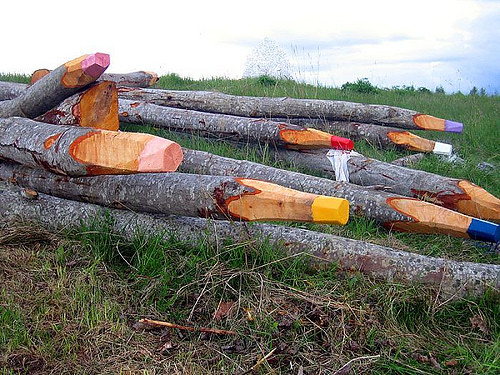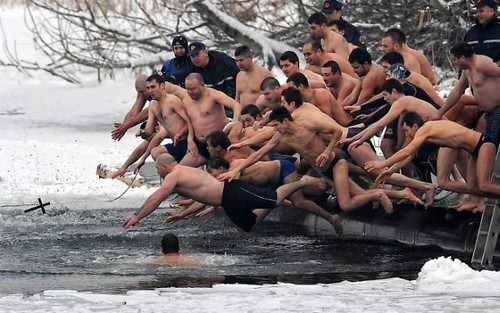Its not necessary to show the video
Its not newsworthy to show images of a dead and dying Gadaffi
We need regulation on this (The last thing we need in Australia is more regulations!)
And then finally someone plays the trump card of all cards and says:
“What about the children?”
Meaning that what if the children see such pictures?
and I think, yes what indeed about the children.

Let children be confronted with problem situations.
I know one way to get the moaners and groaners, moaning and groaning and getting the regulators sharpening their pencils and salivating at the prospect of making even more regulations.
When children see the video of Gadaffi being killed then as a psychologist I can say that they will be a bit more, wait for it.....
desensitised to violence!!
OMG (x10)!!
I can now hear those electric pencil sharpeners whizzing and whirring at a frantic pace now.

That is an interesting phrase
Children desensitising to violence.
I’ll tell you what I will do. I will say the same thing but with different words.
By watching that video of Gadaffi dying children will have an opportunity to develop their psychological resilience.
Now that sounds much better. Not desensitising to violence but developing resilience!
Desensitizing to violence and developing resilience are the same thing.
Now all the huffers and puffers will be chortling that developing resilience is a very good thing and we want our children to develop their resilience and become resilient. That is a very good sounding thing indeed they will pronounce.
A central part of a child developing psychological resilience is to desensitise to repugnant images such as people being killed. Not to become a cold, hard machine but to desensitise to violence at a healthy level.
If you don’t regularly desensitise then one becomes hypersensitized. If we completely sanitise a child’s world then it can never develop resilience to the unsanitary. If we remove all repugnant images, from the severe to the mild, from children then they are going to become hypersensitized to them. And I am afraid to say that in Australia we have done precisely that. In Australia we are a group of hypersensitized wooses when it comes to images and videos of the demise of Mr Gadaffi.

I have said this before here.
Australians are nation of neurotic necrophobics. By sanitising our lives of seeing death on TV and so forth we have become hypersensitized to it and now have a national phobia about seeing dead people.
You have to let children see such things or they wont desensitise to them and will become hypersensitized to them. I am not suggesting you sit children down in front of a TV to watch violence for an hour or so but be realistic about what they see in day to day activity on the TV, the internet, newspapers and so forth.
Then yes you deal with it a clear and effective way. If I was watching TV with my young children and the Gadaffi death video came on this is a summation of the dialogue that would happen. It would probably be longer than this but this gives the general idea.

Developing resilience
Children: What’s happening there daddy?
Father: That man is a called Mr Gadaffi and he is hurt.
C: Who is he?
F: He is the president of a country that is near the pyramids like you drew pictures of at school
C: What are those people doing?
F: They are probably going to kill Mr Gadaffi because he has been a bad man. He hurt lots and lots of people and those people are angry at him. Its called revenge, like when your sister hits you and then you want to hit her back.
C: Why are they all shouting?
F: Because they are very excited and angry at catching him hiding. That red stuff on his head is blood.
C: How did he get that?
F: He has probably been shot with a gun. When people get shot blood comes out. If you get shot in the leg, or bum (to which there are snickers and giggles because daddy said a rude word) or head blood comes out. It looks a bit scary doesn’t it?
C: Yes it is a bit scary.
F: Oh well these things happen and if you treat people nice they are nice back to you.
Maybe more on feelings and thoughts about the thing and then that is about that. Problem solved and the children have had a chance to develop a bit of resilience. It is OK to say words to children like kill, shot in head and blood. It’s not going to traumatise them for life. More importantly its how the adult in the dialogue above does it in an open and clear way without a fear or horror about the whole thing. If the children see the father handle it in an OK way then the children will see it for what it is and have their questions answered as well.
Graffiti
When I was 16 I did a week 'work experience' with the police. I spent an afternoon at HQ crime lab and they showed me their collection of 'best' photos. Included was a series where I saw a head, legs, arms and torso from a female. All of these parts were pictured how they had been found in plastic bags. It didn't upset me.
ReplyDeleteI must say that I thought in the uk was it really necessary to put bloody dead gadaffi all over the front pages. But your post makes sense.
Maybe you were a resilient 16 year old Kahless
ReplyDeleteGraffiti